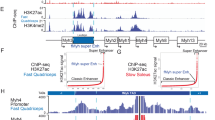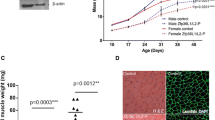Abstract
The porcine perinatal myosin heavy chain (MyHC) is a major isoform in foetal skeletal muscles. We report here on its cDNA and genomic isolation, molecular characterisation and expression. Exon 2 and the first 4 bases of exon 3 of the perinatal MyHC gene, both part of the 5′-end untranslated region, showed differential splicing. About 2% of all perinatal MyHC transcripts of a 50-day-old foetus were without exon 2 and about half were without the 4 bases at the 5′-end of exon 3. Perinatal MyHC mRNA was expressed in all hind limb muscles of a 45-day-old foetus along with the slow and embryonic MyHC isoforms in the same fibres. Unlike other sarcomeric MyHCs reported to date, the porcine perinatal promoter is clustered with repeat elements (4 SINEs and 1 microsatellite) and is without a consensus TATA box at the predicted site upstream of exon 1. Nonetheless, in reporter gene transfections, its promoter was found to be highly muscle-specific. The absence of a TATA box may point to a fundamental difference in the regulatory function between the perinatal and adult MyHC isoforms.
Similar content being viewed by others
References
Blau HM, Chin CP and Webster C (1983) Cytoplasmic activation of human nuclear genes in stable heterocaryons. Cell 32: 1171–1180.
Chang KC and Fernandes K (1996) A strategic shot-gun approach to cloning of isoform-specific myosin cDNAs. Basic Appl Myol 6: 351–356.
Chang KC, Fernandes K and Dauncey MJ (1995) Molecular characterization of a developmentally regulated porcine skeletal myosin heavy chain gene and its 5′ regulatory region. J. Cell Sci. 108: 1779–1789.
Chang KC, Fernandes K and Goldspink G (1993) In vivo expression and molecular characterization of the porcine slow-myosin heavy chain. J Cell Sci 106: 331–341.
Cho M, Webster SG and Blau HM (1993) Evidence for myoblast-extrinsic regulation of slow myosin heavy chain expression during muscle fiber formation in embryonic development. J Cell Biol 121: 795–810.
Codon K, Silberstein L, Blau HM and Thompson WJ (1990) Development of muscle fiber types in the prenatal rat hindlimb. Dev Biol 138: 256–274.
Eller M, Stedman HH, Sylvester JE, Fertels SH, Rubinstein NA, Kelly AM and Sarker S (1989) Nucleotide sequence of full length human embryonic myosin heavy chain cDNA. Nucleic Acids Res 17: 3591.
Jullian EH, Kelly AM, Pompidou AJ, Hoffman R, Schiaffino S, Stedman HH and Rubinstein NA (1995) Characterization of a human perinatal myosin heavy-chain transcript. Eur J Biochem 230: 1001–1006.
Karsch-Mizrachi I, Feghali R, Shows TB and Leinwand LA (1990) Generation of a full-length human perinatal myosin heavy-chain-encoding cDNA. Gene 89: 289–294.
Perisamy M, Wiezorek DF and Nadal-Ginard B (1984) Characterization of a developmentally regulated perinatal myosin heavy chain gene expressed in skeletal muscle. J Biol Chem 259: 13573–13578.
Sambrook J, Fritsch EF and Maniatis T (1989) Molecular cloning: a laboratory manual. (second edition) Cold Spring Harbor Press, New York.
Schiaffino S and Reggiani C (1996) Molecular diversity of myofibrillar proteins: gene regulation and functional significance. Physiol Rev 76: 371–423.
Singer DS, Parent LJ and Ehrlich R (1987) Identification and DNA sequence of an interspersed repetitive DNA element in the genome of the miniature swine. Nucleic Acids Res 15: 2780.
Sutherland CJ, Elsom VL, Gordon ML, Dunwoodie SL and Hardeman EC (1991) Coordination of skeletal muscle gene expression occurs late in mammalian development. Dev Biol 146: 167–178.
Takeda S, North DL, Lakich MM, Russell SD and Whalen RG (1992) A possible regulatory role for conserved promoter motifs in an adult-specific muscle myosin gene from mouse. J Biol Chem 267: 16957–16967.
Weiss A, Mcdonough D, Wertman B, Acakpo-Satchivi L, Montgomery K, Kucherlapati R, Leinwand L and Krauter K (1999a) Organisation of human and mouse skeletal myosin heavy chain gene clusters is highly conserved. Proc Natl Acad Sci USA 96: 2958–2963.
Weiss A, Schiaffino S and Leinwand LA (1999b) Comparative sequence analysis of the complete human sarcomeric myosin heavy chain family: implications for functional diversity. J Mol Biol 290: 61–75.
Weydert A, Bonhomme F, Catalan J, Simon D, Guenet JL, Gros F and Buckingham ME (1985) Genes for skeletal muscle myosin heavy chains are clustered and are not located on the same mouse chromosome as a cardiac myosin heavy chain gene. Proc Natl Acad Sci USA 82: 7183–7187.
Wigmore PMC and Stickland NC (1983) Muscle development in large and small pig fetuses. J Anat 2: 235–245.
Yu YT and Nadal-Ginard B (1989) Interaction of nuclear proteins with a positive cis-acting element of rat embryonic myosin heavy-chain promoter: identification of a new transcription factor. Mol Cell Biol 9: 1839–1849.
Author information
Authors and Affiliations
Rights and permissions
About this article
Cite this article
Costa, N.D., Beuzen, N., Johnston, I. et al. The 5′-end of the porcine perinatal myosin heavy chain gene shows alternative splicing and is clustered with repeat elements. J Muscle Res Cell Motil 21, 183–188 (2000). https://doi.org/10.1023/A:1005660718348
Issue Date:
DOI: https://doi.org/10.1023/A:1005660718348




